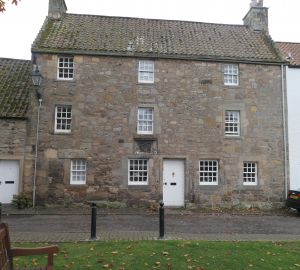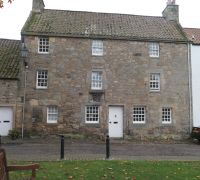Brunton House: Difference between revisions
No edit summary |
No edit summary |
||
| Line 26: | Line 26: | ||
'''Brunton House''', [[Brunton Street]] is a private house, once the residence of the hereditary falconers to the Kings of Scotland. | '''Brunton House''', [[Brunton Street]] is a private house, once the residence of the hereditary falconers to the Kings of Scotland. | ||
It is probably | It is probably older than the date of 1712 on the armorial panel. | ||
It was restored in 1894–95 for the [[third Marquess of Bute]] by [[Robert Weir Schultz]] as a school for the Roman Catholic children of the village, and refurbished in 1910 for use for use by [[Lord Ninian]]'s chaplain,<ref name=playfair />. In 1953 Major [[Michael Crichton Stuart]] presented it to the [[National Trust for Scotland]]. | It was restored in 1894–95 for the [[third Marquess of Bute]] by [[Robert Weir Schultz]] as a school for the Roman Catholic children of the village, and refurbished in 1910 for use for use by [[Lord Ninian]]'s chaplain,<ref name=playfair />. In 1953 Major [[Michael Crichton Stuart]] presented it to the [[National Trust for Scotland]]. | ||
Revision as of 12:40, 9 January 2021
| Building details | |
|---|---|

| |
| Name | Brunton House |
| Address | Brunton Street KY15 7BQ |
| Other names | Marchioness Dowager of Bute’s private school [1] |
| Date | 17th century |
| OS grid ref | NO 25239 7311 |
| Latitude & longitude | 56°15′09″N 3°12′29″W |
| Listing | Category A |
| Listing ref | LB31328 |
| Listing name | Brunton House, Brunton Street (including garden walls) |
Brunton House, Brunton Street is a private house, once the residence of the hereditary falconers to the Kings of Scotland.
It is probably older than the date of 1712 on the armorial panel.
It was restored in 1894–95 for the third Marquess of Bute by Robert Weir Schultz as a school for the Roman Catholic children of the village, and refurbished in 1910 for use for use by Lord Ninian's chaplain,[1]. In 1953 Major Michael Crichton Stuart presented it to the National Trust for Scotland.
It was restored in 1970 by the NTS under the Little Houses Improvement Scheme.[2]
Listing description
Dated 1712 at sculptured armorial panel, 3-storey 3-window, coursed rubble, moulded doorpiece; crowstepped and pantiled with slate skirting. Crowstepped stair tower at back.[3]
Former residents
- 1906: George Lumsden)[1]
- Around 1906: Mrs O'Connor (teacher / manageress)[1]
- 1911: Henley Woods (Roman Catholic Priest), aged 54, and his sister Cecilia Woods aged 32, both from Edinburgh and a servant (housekeeper), Lily Preston aged 28, from Ireland.[4]
Further references
- Gifford, Fife, page 221.
- Pride, Kingdom of Fife, page 87. "A three-storey masterpiece in coursed rubble, pantiles and crowsteps."
- Canmore
- Wikipedia
Notes
- ↑ 1.0 1.1 1.2 1.3 Playfair and Burgess
- ↑ Diane Watters and Miles Glendenning, Little Houses; The National Trust for Scotland's Improvement Scheme for Small Historic Homes (RCAHMS and NTS, 2006, page 105).
- ↑ Brunton House, Brunton Street (including garden walls), Historic Environment Scotland.
- ↑ 1911 census
Gallery
[Click on a thumbnail below to see an enlarged image]
-
Brunton House in 2018
-
Armorial panel on the front of the house, dated 1712

